
St Mary, SHIREHAMPTON
Bristol
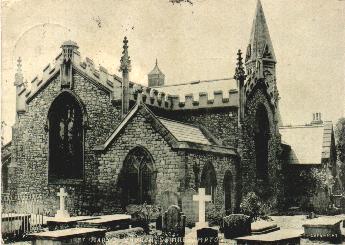 |
The manor was originally part of the lands of the monastic church (later College) of Westbury-on-Trym, who may have established a church here. At the Dissolution of the Monasteries the lands were granted to Sir Ralph Sadlier, and he was tasked with reproviding for Divine Service but Shirehampton does not seem to be one. The earliest mention of a chapel-of-ease at Shirehampton is in the records of Westbury-on-Trym parish church, recording a baptism here in 1579. This chapel - of uncertain date - was replaced by a new one in 1727, on the current site. It is uncertain whether this was also the site of the earlier structure. This chapel was again rebuilt in enlarged form in 1827, in an early Gothic form with plaster vaults, cruciform. It finally became a parish church in 1844. |
| There were further
enlargements in 1860, 1889 and 1906. In its final form it
had a rather silly turret at the west end, and a north
aisle and north vestry/chapel, and an arch in the south
sanctuary seems to have led to an organ loft. The nave's north arcade was rather out of proportion to the rest, and was quite a serious piece of architecture, and somewhat jarring. This can be seen in the picture above. However this church was destroyed by fire on the morning of Sunday 15th January 1928. |
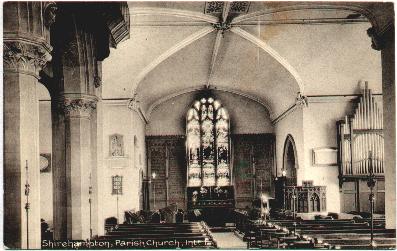 |
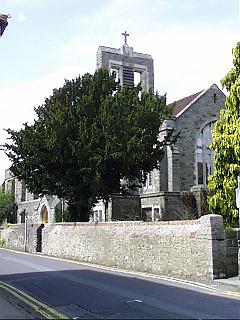 |
The parishioners responded
to appeals for funds immediately and a new church was
built on the site. However it is almost twice the size of
the original and built on a slightly different axis. the
site of the original high altar is marked in the floor of
the nave by a stone with five consecration crosses on it
showing the former axis. The architect was P. Hartland Thomas, work began in 1929 and the church consecrated two years from the day it was destroyed, 15th January 1930. The church is still Gothic in feel but treated in an entirely modern way. These two pictures show the view from the SE (left) and NE. Over the chancel arch is an effectively large double bellcote of stepped outline rising from the churchyard to the cross at the apex. |
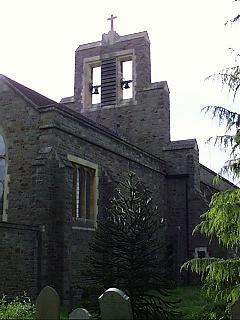 |
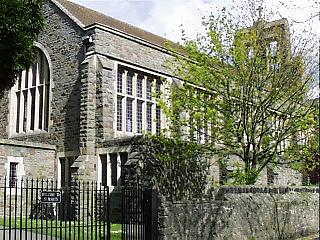 |
From the south-west the proportions of the nave and aisles can be seen. The aisles are low, and the clerestory particularly large with five-light transomed windows. The west and east windows (also with transoms), together with the doorway from the narthex have pointed arches. | 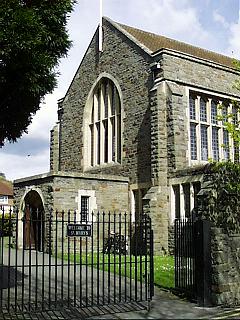 |
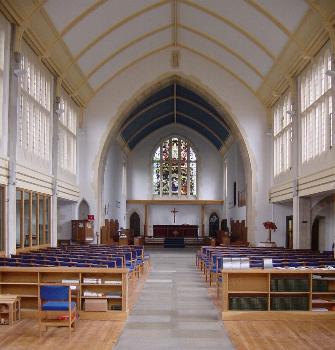 |
As a consequence of the
clerestory, the interior is flooded with light. It is
wide and spacious, the aisles little more than side
passages. The short rectangular piers continue up as
pilasters to divide the bays at clerestory level, and
carry transverse arches in the aisles. A low vestry is
provided beyond the chancel, accessed by two doors. The
pointed chancel arch is echoed by the pointed arches of
the main roofs. The church has been totally refurbished and redecorated since September 2001. The old seating previously shown on this page has been replaced. The west two bays of the aisles have been converted into a Church Office, a Store Room, disabled toilet facilities, and a much used catering kitchen. The Lady Chapel has been enclosed by a glazed screen. The once dark Canadian pine floorboards have been stripped and cleaned providing a light and airy reflection to the streaming sunlight through the clerestory windows and the west end of the nave is cleared of seating for flexible usage. |
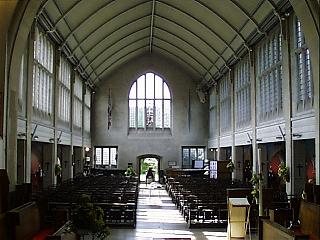 |
Compare the pre2001
picture (left) with the 2007 picture (right). The west window seems a perfect match for the east one, and indeed now has the latter's former glass, a World War Memorial window (replacing one lost in the fire) Christ Crucified with Roman Soldiers, by Geoffrey Robinson of Bell & Sons of Bristol. |
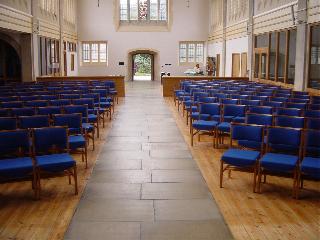 |
|
The new east window is the
work of H.J.Stammers and was inserted in 1961. It depicts
the Nativity, and most of the children of
"Shire" will remember the Shire Wheelbarrow, at
the foot of the left-hand light, with fondness I am sure.
Unfortunately my zoom photo cuts part of this off -
sorry! I think the recent work at St Mary's has been a success, alterations to fulfill the needs of the parish without destroying the interior space and feel. |
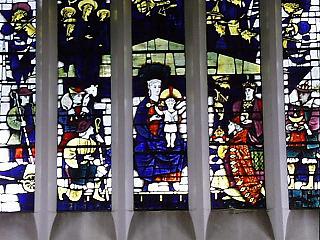 |
| The
greatest treasures of the church are now shown in new
display cases in the church. The Shirehampton Missal is
an absolutely stunning piece of art by a late member of
the church, the late Miss Irene Base. It is on parchment,
gilded and painted, the complete order of service for
Holy Communion in fine calligraphy. It took her many many
years to do this and it looks like the illuminated books
of medieval times. Around the church are other examples
of her work. Unknown to the vicar, Miss Base had also
embarked on a further piece of work despite failing
health and that has been bound into a second volume. Also
shown is an ancient prayer book dating from 1682 and
other items of local interest. St Mary's is usually open, indeed the west door is literally kept open wide, as the churchyard is used by the locals to cut through from the High Street bus stops and shops, to the Health Centre behind. Many can be seen glancing inside as they pass. A refreshing change in our cities, and one to be encouraged. |
|
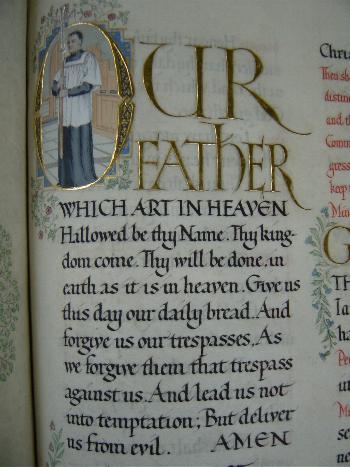 |
(The description above revised from information from David Froude in a February 2007 Email. He also adds that gifts of new stained glass windows are in course of installation at the West end depicting the Nativity and the Crucifixion. The organ was completely refurbished in 2006 and the recent addition of a grand piano will enable the frequent concerts and other musical events to benefit from the acclaimed acoustics the refurbishment programme has provided at this warm, comfortable and welcoming church. St Mary's Shirehampton came second in the National Competition of Ecclesiastical Insurance - Your Church in a Changing Society - come and see us, enjoy our welcome and see why more than five times as many worship here than five years ago. Pictures of St Mary's, Shirehampton together with details of services, numerous events and activities can be found on the web at www.shirehampton.2day.ws " The new interior pictures and details from the Missal are his pictures, used with permission. |
Back to Bristol churches Index
page updated 21st March 2007